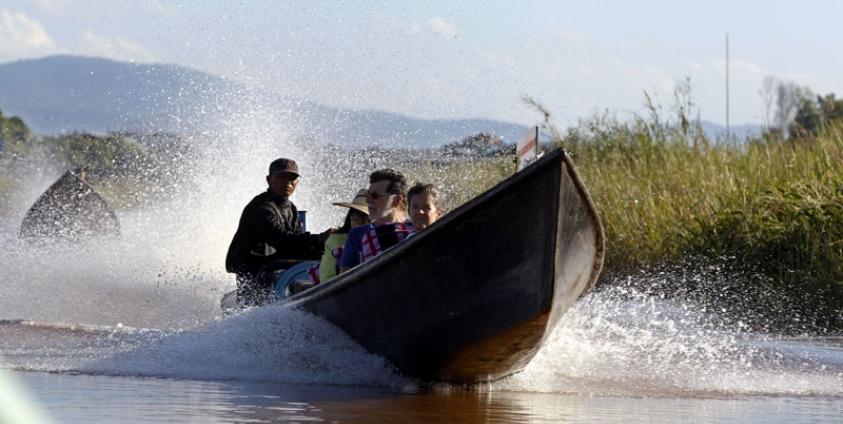Transparency a major concern in maintaining Inlay Lake
A change in Myanmar’s second largest lake was noticed by 35-year-old fisherman, Ko Yan Naing, three months ago. He started to catch shrimp on Inlay Lake because he found it was getting harder to find fish. This was the first time in his 10-year career as a fisherman that he has had to switch to the work to bring in shrimp. He said many fishermen are extending their working hours – night and day in some cases - in order to maintain their original fishing catch. Others find they have to take up jobs on plantations to bring in extra income to get by, he said.
Inlay Lake – also spelled Inle Lake - is one of Myanmar’s natural beauties and a tourist draw. But the ecological situation of the lake is deteriorating at a dramatic rate due to the run-off from the use of artificial fertilizers and pesticides, deforestation and climate change. The lake is an important staging point for migratory birds and home to many indigenous and endemic species. Around 168,000 people live on and around the lake, and largely because of this burgeoning population, the condition of the lake is getting worse.
A plan for the rescue of the lake is the need of the hour. But there are questions, with concerns voiced about the need for more local involvement.
The Ministry of Environmental Conservation and Forestry inaugurated new five-year conservation plans on July 7 with the Norwegian Embassy and UN agencies. The lake became the first United Nations Educational, Scientific and Cultural Organization (UNESCO) biosphere reserve of Myanmar in June. Previously, the United Nations Development Programme (UNDP) implemented a conservation project during 2012-2015 with the Myanmar government and financial support from the Norwegian government.
Ko Yan Naing has never heard of these plans. “Were they on television?” he asked. This fisherman’s surprise highlights the ongoing trouble of government transparency amongst the local population in the country.
U Maung Nge, 43, a farmer for over three decades, started to fish one month ago, after his floating farm next to the lake dried up due to insufficient water supplies. He also voiced his concerns about government transparency and the ecological and climatic changes unfolding. “I didn’t receive any help from the government,” he said. “I have never been invited to any meetings organized by the government… I don’t really know what kinds of plans they have made.”
The 30-page five-year action plan addresses sustainable agriculture and tourism, restoration of forests in watershed areas and improvement of lake residents’ livelihood – priority issues. The ministry will start the project from January 2016 with a proposed budget of US$32 million, according to the document.
The 130-page long-term plan details the conservation activities for an initial period of ten years including soil retention measures in shifting cultivation areas, systematic solid waste management, and protection of indigenous fish species.
Both documents stress the integrated, community-based approaches involving all stakeholders. However, some farmers and local representatives are hoping for more transparency and information from the government side.
U Than Aung, 51, has tended to his floating tomato farm for over 10 years. He said he attended some meetings about environmental conservation. However, he said he still knows little about the conservation plans, and that the chemical products the organizers suggested he use did not meet his needs.
The Shan State Government officially formed the Lake Authority on July 6 to promote sustainability and conservation of Inlay Lake and to protect the livelihood of the inhabitants. The Lake Authority group consists of ministers from Shan State government and Livestock Ministry, the minister for environmental conservation and forestry, and a parliament member and two state representatives from Nyaung Shwe.
Some local representatives who attended the July 7 launch and consultation workshops on conservation plans raised concerns about the institution’s transparency, and said they didn’t know about it prior to its establishment.
“We didn’t know they have formed the Lake Authority,” U Khin Maung Latt, a boatman and communications officer of Inlay Farmer, an agricultural and community development group. “The Lake Authority is essential for the development of the lake… But if it isn’t transparent, it won’t be effective.”
Local people’s participation is key to the success of the plans, U Win Naing Thaw, director of Nature and Wildlife Conservation Division, said. “Therefore, we encourage local society, civil society organizations, community-based organizations to educate the local people about the concept of bio-diversity.”
Training and transparency are important, according to one of the stakeholders.
“We will organize more training courses and awareness-raising workshops,” U Bo Ni, director of Watershed Management Division, said. “We will form a committee under the Lake Authority to communicate with and inform the local people.”
This Article first appeared in the July 16, 2015 edition of Mizzima Weekly.
Mizzima Weekly is available in print in Yangon through Innwa Bookstore and through online subscription at www.mzineplus.com







